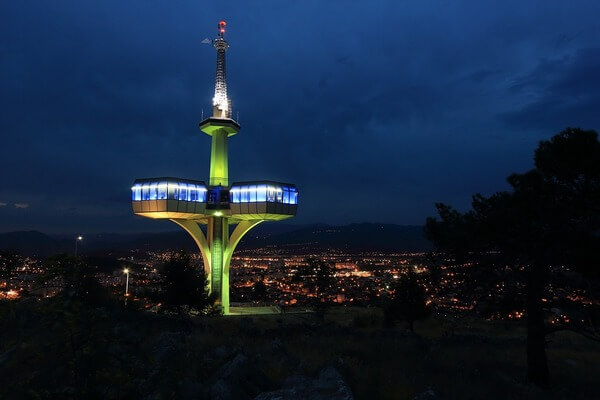News Release from windfair.net
Wind Industry Profile of
Energy Transition in the Balkan States
Only a month ago, Croatian Environment and Energy Minister Tomislav Coric announced at WindEurope 2019 that his country plans to increase its wind energy capacity by a factor of three and solar energy capacity by a factor of 20 over the next 10 years. Although Croatia - like almost all Balkan countries - has a high share of hydropower (almost 25 percent), the wind and solar sectors are still in their infancy.
Fossil fuels are the main energy sources to generate electrical and thermal energy in the Mediterranean country. In addition, the Krško nuclear power plant in Slovenia, a joint project of the two countries, supplies the north of Croatia and the city of Zagreb with electricity. In addition, energy is imported - but that is expensive. No wonder the Croatian authorities now think that a further increase in investment in the renewables will boost job creation and industrial growth in the country, according to Balkan Green Energy News.

Hydropower traditionally accounts for a large share of electricity production in the Balkans (Image: Pixabay)
After all, EU member Croatia isn't immune to the requirements of the European Union. With wind and other renewable energy sources, the country wants to increase its share of renewable energies in gross energy consumption to 32% by 2030 and at least 56% by 2050.
A long way to go, as figures from Croatia's Green Paper show, which contains analyses for the preparation of a development strategy for the country's energy sector. According to this study, by mid-2018 the country had 22 wind turbines with a total installed capacity of 573 MW, while another five turbines with a total installed capacity of 162 MW were under development and/or construction. The construction of the remaining plants should be completed by the end of 2020. Croatia's solar capacity has also been tiny to date: at the end of 2017, 1,223 solar power plants with a total installed capacity of 51.49 MW were in operation and received subsidies as well as eight other projects with a capacity of 1,972 MW were under development or construction.

The observation tower Toranj na Dajbabskoj Gori above the capital of Montenegro, Podgorica (Image: Pixabay)
The situation is similar in other Balkan countries, such as Montenegro. Croatia's southeastern neighbour has only been independent since 2006 and has just over 642,000 inhabitants. But here, too, there are efforts to invest more in renewable energies in the future.
However, this can't be done without help from abroad. In 2015 the European Bank for Reconstruction and Development (EBRD), supported by Norway, financed the Montenegrin wind farm Krnovo. According to The Financial, this was the country's first private power generation project and the first major investment in power generation since the 1980s. Today, the wind farm accounts for eight percent of the total installed capacity and contributes six percent to power generation in Montenegro. It supplies 100,000 households with green electricity and at the same time avoids more than 180,000 tons of CO2 emissions per year.
 "In a country where thermal power is still a major source of electricity, Montenegro's use of its abundant wind resource is key to improving capacity generation in the country," says Jaap Sprey, the EBRD’s Head of Montenegro. "The Krnovo wind farm (see image left: akuo energy), located in Niksic in the Central-Western part of Montenegro sets a perfect example of the EBRD’s impact in the region."
"In a country where thermal power is still a major source of electricity, Montenegro's use of its abundant wind resource is key to improving capacity generation in the country," says Jaap Sprey, the EBRD’s Head of Montenegro. "The Krnovo wind farm (see image left: akuo energy), located in Niksic in the Central-Western part of Montenegro sets a perfect example of the EBRD’s impact in the region."
A lack of administrative capacity is the key bottleneck for further promotion of green electricity. However, with the support of the experienced Norwegians, the Bank has now created a stronger legal framework for sustainable energy projects in cooperation with the country's authorities. These include support for the level of feed-in tariffs, the development of government support schemes and the development of a bankable power purchase agreement for green power projects.
Cross-border projects in particular should help the entire region of South Eastern Europe in the future - at least according to the will of the EU, which will provide financing of EUR 1.3 billion for cross-border cooperation in infrastructure projects in the field of renewable energies between 2021 and 2027. In addition to financing renewables, grid connection and energy storage projects will also be supported.
Not an easy undertaking in countries that are still marked by mistrust from war days. "We see integration as a very powerful instrument for expanding trade in goods and services, increasing cross-border investment and, perhaps most important, encouraging the exchange of new ideas and innovation," EBRD President Sir Suma Chakrabarti said recently. He referred to integration through physical infrastructure that connects regions via roads, railways, ports, airports and telecommunications, making it easier to move people and goods. As early as 2018, Montenegro was able to surprise with economic growth of almost five per cent.
Ultimately, the Northern European countries are demonstrating that the interconnection of energy systems is the right step to take, especially when it comes to energy transition.
- Author:
- Katrin Radtke
- Email:
- press@windfar.net
- Keywords:
- energy transition, Balkan, Croatia, Montenegro, wind energy, solar, hydropower, wind farm, financing, EBRD




























